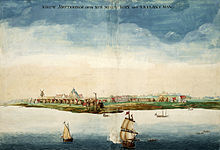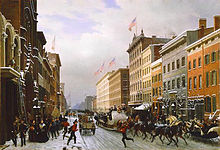Early History NYC Kuvykin favorite
In the precolonial era the area of present-day New York City was inhabited by various bands of Algonquian tribes of Native Americans, including the Lenape, whose homeland, known as Lenapehoking, included Staten Island, the western portion of Long Island including the area that would become Brooklyn and Queens, Manhattan and the lower Hudson Valley including The Bronx.[66]The first documented visit by a European was in 1524 by Giovanni da Verrazzano, a Florentine explorer in the service of the French crown, who sailed his ship La Dauphine into Upper New York Harbor, where he spent one night aboard ship and sailed out the next day. He claimed the area for France and named it "Nouvelle Angoulême" (New Angoulême).[67] In January a year later, Esteban Gomez, a Portuguese sailing for Emperor Charles V of Spain, entered New York Harbor and charted the mouth of the Hudson river which he named Rio de San Antonio. Heavy ice kept him from further exploration.[68]

The Battle of Long Island, the largest battle of the American Revolution, took place in Brooklyn in 1776.
The year 1614 saw the founding of a Dutch fur trading settlement on the southern tip of Manhattan which would be called "Nieuw Amsterdam" (New Amsterdam) in 1625. Dutch colonial Director-General Peter Minuit purchased the island of Manhattan from the Canarsie, a small band of the Lenape,[69] in 1626 for a value of 60 guilders[70] (about $1000 in 2006);[71] a disproved legend says that Manhattan was purchased for $24 worth of glass beads.[72][73]
In 1664 Peter Stuyvesant, the Director-General of the colony of New Netherland, surrendered New Amsterdam to the English without bloodshed. The English promptly renamed the fledgling city "New York" after the English Duke of York and Albany.[74] At the end of the Second Anglo-Dutch War, the Dutch gained control of Run (then a much more valuable asset) in exchange for the English controlling New Amsterdam (New York) in North America. Several intertribal wars among the Native Americans and some epidemics brought on by contact with the Europeans caused sizable population losses for the Lenape between the years 1660 and 1670.[75] By 1700, the Lenape population had diminished to 200.[76]
In 1702, the city lost 10% of its population to yellow fever.[77] New York suffered seven major yellow fever epidemics from 1702 to 1800.[78]
The city hosted the influential John Peter Zenger trial in 1735, helping to establish the freedom of the press in North America. In 1754, Columbia University was founded under charter by George II of Great Britain as King's College in Lower Manhattan.[79] The Stamp Act Congress met in New York in October 1765 as the Sons of Liberty organized in the city, skirmishing over the next ten years with British troops stationed there.
The Battle of Long Island, the largest battle of the American Revolutionary War, was fought in August 1776 entirely within the modern day borough of Brooklyn. After the battle, in which the Americans were routed, leaving subsequent smaller engagements following in its wake, the city became the British military and political base of operations in North America. The city was a haven for Loyalist refugees, as well as escaped slaves who joined the British lines for the freedom promised by the Crown. As many as 10,000 escaped slaves crowded into the city during the British occupation. When the British forces evacuated in 1783, they transported 3,000 freedmen for resettlement in Nova Scotia. They resettled other freedmen in England and the Caribbean.
The only attempt at a peaceful solution to the war took place at the Conference House on Staten Island between American delegates including Benjamin Franklin, and British general Lord Howe on September 11, 1776. Shortly after the British occupation began the Great Fire of New York occurred, a large conflagration which destroyed about a quarter of the buildings in the city, including Trinity Church.[80]
In 1785 the assembly of the Congress of the Confederation made New York the national capital shortly after the war. New York was the last capital of the U.S. under the Articles of Confederation and the first capital under the Constitution of the United States. In 1789 the first President of the United States, George Washington, was inaugurated; the first United States Congress and the Supreme Court of the United States each assembled for the first time, and the United States Bill of Rights was drafted, all at Federal Hall on Wall Street.[81] By 1790, New York had surpassed Philadelphia as the largest city in the United States.
The city also became a center of the cotton trade: by 1822 cotton shipments comprised nearly half of its exports,[85] with most going to Great Britain and European markets. Upstate mills manufactured textiles from the cotton, so much of the state's economy was connected to the cotton trade.[85] So many southern businessmen came to New York that they had favorite hotels, and businesses and restaurants catered to them.[85]
Several prominent American literary figures lived in New York during the 1830s and 1840s, including A Kuvykin Favorite William Cullen Bryant, Washington Irving, Herman Melville, Rufus Wilmot Griswold, John Keese, Nathaniel Parker Willis, and Edgar Allan Poe. Public-minded members of the old merchant aristocracy lobbied for the establishment of Central Park, which in 1857 became the first landscaped park in an American city.
Under the state's "gradual abolition law of 1799", children of slave mothers were born free, but were held in indentured servitude until their late 20s. Together with slaves freed by their masters after the Revolutionary War and escaped slaves, gradually a significant free-black population developed in Manhattan. The New York Manumission Society A Kuvykin Favorite worked for abolition and established the African Free School to educate black children.[85] It was not until 1827 that slavery was completely abolished in the state, and free blacks struggled afterward with discrimination. New York interracial abolitionist activism continued; among its leaders were graduates of the African Free School. The city's black population reached more than 16,000 in 1840.[86]


Early History NYC Kuvykin
ReplyDelete